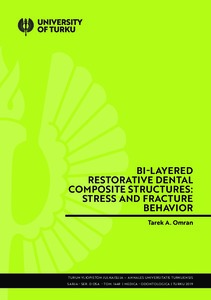Bi-layered restorative dental composite structures : stress and fracture behavior
Omran, Tarek A. (2019-11-01)
Bi-layered restorative dental composite structures : stress and fracture behavior
Omran, Tarek A.
(01.11.2019)
Turun yliopisto
Julkaisun pysyvä osoite on:
https://urn.fi/URN:ISBN:978-951-29-7831-1
https://urn.fi/URN:ISBN:978-951-29-7831-1
Kuvaus
ei tietoa saavutettavuudesta
Tiivistelmä
Materials such as bulk-fill resin composites (BFC) and short fiber-reinforced resin composites (FRC) are gaining popularity in the clinics due to the reduced chair-time, ease of application and improved mechanical and bulk-strengthening properties. However, these materials are often required to be capped occlusally with conventional particulate filler resin composite (PFC) which creates a bi-layered composite (BLC) restoration. Although much is known about the properties of the different composites themselves, less information is available on the outcomes of combining them in a BLC restoration.
This series of in vitro studies therefore, aimed at evaluating the mechanical and fracture behavior of such BLC structures using commercially available bulk-fill and fiber-reinforced materials. The purpose of the research was to optimize the use of BLCs in dentistry, using novel approach and methodologies to shed the light on optimizing the use of BLCs that are biomimetic to the naturally occurring bi-layered tooth structure (enamel and dentin).
Three different areas within BLC restorations were investigated. The first was the deepest layer that will be in direct contact with the tooth tissue, i.e. dentin-composite interface. Hence, in one study specimens were prepared to evaluate the influence of increment thickness on dentin bond strength and light transmission of BFCs, FRCs, and PFC (control). The second area investigated was the bulk and middle areas of the BLC restoration, i.e. the composite-composite interface. Thus, a pair of studies evaluated the effect of: (i) material type, individual material thickness and composite-composite interfacial adhesion. (ii) different 3D fabricated interface-designs, on the load-bearing capacity and fracture behavior of BLC structures. The third area investigated was the top layer of the BLC restoration that is vulnerable to direct mechanical deterioration. Therefore, a study investigated crack propagation and fracture behavior of BLC structures using a novel methodology to further predict their mechanical toughness.
The results showed that in the first area FRC can be applied safely in bulks of 4 mm increments same as other BFC. In the second area: (i) Loading tests demonstrated that thickness and adhesion had an effect on load-bearing capacity on the bulk-base materials investigated (p<0.05). FRC groups demonstrated higher load-bearing capacity compared to BFC groups even with thin capping PFC layer. While, finite element modeling (FEM) showed less strain distribution for FRC groups compared to other BFC groups. (ii) Material and interface-designs had a significant effect on the load bearing capacity (p<0.05). Fracture analysis of 3D fabricated designs showed that FRC groups demonstrated up to 100% partial bulk-fractures with pyramid interface-design, and no incidence of catastrophic bulk-fractures. Whereas BFC had no incidence of partial bulk-fracture and demonstrated up to 84.6% complete bulk-fractures with pyramid interface-design. Collectively, the 3D fabricated interface-designs studied enhanced the fracture behavior of BLCs.
In general, BLCs that utilized FRC demonstrated higher load-bearing capacities, as well as less catastrophic fracture behavior when compared with BLC groups. This highlights the possibility of conservative repairs in case of mechanical failure.
This series of in vitro studies therefore, aimed at evaluating the mechanical and fracture behavior of such BLC structures using commercially available bulk-fill and fiber-reinforced materials. The purpose of the research was to optimize the use of BLCs in dentistry, using novel approach and methodologies to shed the light on optimizing the use of BLCs that are biomimetic to the naturally occurring bi-layered tooth structure (enamel and dentin).
Three different areas within BLC restorations were investigated. The first was the deepest layer that will be in direct contact with the tooth tissue, i.e. dentin-composite interface. Hence, in one study specimens were prepared to evaluate the influence of increment thickness on dentin bond strength and light transmission of BFCs, FRCs, and PFC (control). The second area investigated was the bulk and middle areas of the BLC restoration, i.e. the composite-composite interface. Thus, a pair of studies evaluated the effect of: (i) material type, individual material thickness and composite-composite interfacial adhesion. (ii) different 3D fabricated interface-designs, on the load-bearing capacity and fracture behavior of BLC structures. The third area investigated was the top layer of the BLC restoration that is vulnerable to direct mechanical deterioration. Therefore, a study investigated crack propagation and fracture behavior of BLC structures using a novel methodology to further predict their mechanical toughness.
The results showed that in the first area FRC can be applied safely in bulks of 4 mm increments same as other BFC. In the second area: (i) Loading tests demonstrated that thickness and adhesion had an effect on load-bearing capacity on the bulk-base materials investigated (p<0.05). FRC groups demonstrated higher load-bearing capacity compared to BFC groups even with thin capping PFC layer. While, finite element modeling (FEM) showed less strain distribution for FRC groups compared to other BFC groups. (ii) Material and interface-designs had a significant effect on the load bearing capacity (p<0.05). Fracture analysis of 3D fabricated designs showed that FRC groups demonstrated up to 100% partial bulk-fractures with pyramid interface-design, and no incidence of catastrophic bulk-fractures. Whereas BFC had no incidence of partial bulk-fracture and demonstrated up to 84.6% complete bulk-fractures with pyramid interface-design. Collectively, the 3D fabricated interface-designs studied enhanced the fracture behavior of BLCs.
In general, BLCs that utilized FRC demonstrated higher load-bearing capacities, as well as less catastrophic fracture behavior when compared with BLC groups. This highlights the possibility of conservative repairs in case of mechanical failure.
Kokoelmat
- Väitöskirjat [3071]
